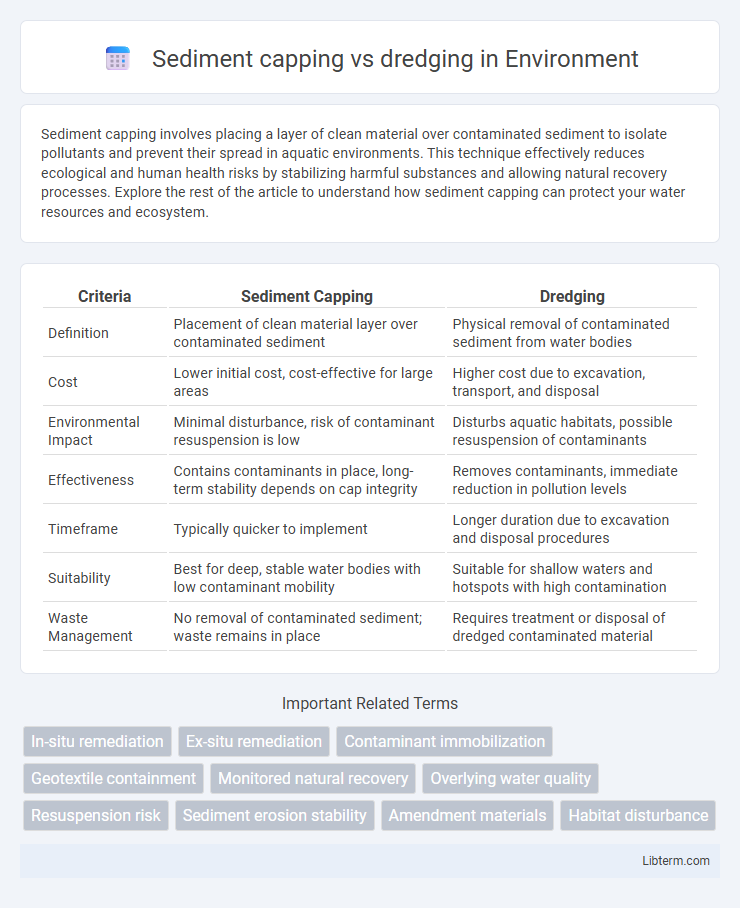Sediment capping involves placing a layer of clean material over contaminated sediment to isolate pollutants and prevent their spread in aquatic environments. This technique effectively reduces ecological and human health risks by stabilizing harmful substances and allowing natural recovery processes. Explore the rest of the article to understand how sediment capping can protect your water resources and ecosystem.
Table of Comparison
| Criteria | Sediment Capping | Dredging |
|---|---|---|
| Definition | Placement of clean material layer over contaminated sediment | Physical removal of contaminated sediment from water bodies |
| Cost | Lower initial cost, cost-effective for large areas | Higher cost due to excavation, transport, and disposal |
| Environmental Impact | Minimal disturbance, risk of contaminant resuspension is low | Disturbs aquatic habitats, possible resuspension of contaminants |
| Effectiveness | Contains contaminants in place, long-term stability depends on cap integrity | Removes contaminants, immediate reduction in pollution levels |
| Timeframe | Typically quicker to implement | Longer duration due to excavation and disposal procedures |
| Suitability | Best for deep, stable water bodies with low contaminant mobility | Suitable for shallow waters and hotspots with high contamination |
| Waste Management | No removal of contaminated sediment; waste remains in place | Requires treatment or disposal of dredged contaminated material |
Introduction to Sediment Capping and Dredging
Sediment capping involves placing a clean layer of material like sand or activated carbon over contaminated sediments to isolate pollutants and prevent their spread, effectively reducing ecological risks without removing the sediments. Dredging physically removes contaminated sediments from the water body, offering immediate pollutant elimination but often requiring handling and disposal of hazardous materials. Both methods serve as critical remediation strategies in managing sediment contamination, with selection dependent on site conditions, contaminant types, and long-term environmental goals.
What is Sediment Capping?
Sediment capping is an in-situ remediation technique that involves placing a layer of clean material, such as sand, activated carbon, or gravel, over contaminated sediments to isolate pollutants and prevent their migration into the water column. This method minimizes exposure to harmful substances by creating a physical and chemical barrier, reducing risks to aquatic ecosystems and human health. Sediment capping is often favored over dredging when it is essential to avoid disturbing fragile habitats or when contaminant resuspension during removal poses significant environmental concerns.
What is Dredging?
Dredging is an environmental remediation technique involving the removal of contaminated sediments from water bodies to improve water quality and restore aquatic habitats. It physically extracts pollutants trapped in sediment layers, preventing further dispersion and reducing ecological and human health risks. This method contrasts with sediment capping, which isolates contaminants by placing a clean layer over polluted sediments, leaving the contamination in place.
Key Differences Between Sediment Capping and Dredging
Sediment capping involves placing a clean layer of material over contaminated sediment to isolate pollutants, whereas dredging removes polluted sediment from the water body entirely. Capping is generally less disruptive to aquatic ecosystems and cost-effective, while dredging offers permanent removal of contaminants but with higher environmental disturbance and expense. The choice depends on site-specific factors such as contamination levels, sediment stability, and remediation goals.
Environmental Impact of Sediment Capping
Sediment capping involves placing a layer of clean material over contaminated sediments, effectively isolating pollutants and reducing contaminant bioavailability and mobility, which minimizes harm to aquatic ecosystems. This method produces less turbidity and resuspension of contaminants compared to dredging, thereby protecting water quality and benthic habitats. Sediment capping also provides a stabilized substrate that supports recolonization of benthic organisms, contributing to habitat recovery without the disturbance caused by sediment removal.
Environmental Impact of Dredging
Dredging disturbs aquatic ecosystems by resuspending contaminated sediments, leading to increased turbidity and the release of toxic substances into the water column. This process negatively impacts water quality, disrupts benthic habitats, and can cause long-term harm to fish and invertebrate populations. Compared to sediment capping, dredging poses higher environmental risks due to sediment upheaval and potential contaminant spread.
Cost Comparison: Sediment Capping vs Dredging
Sediment capping typically offers lower initial costs compared to dredging, as it involves placing clean material over contaminants rather than removing sediment entirely. Dredging expenses escalate due to extensive equipment use, sediment disposal, and water treatment requirements. Long-term monitoring and maintenance costs may vary, but dredging often incurs higher environmental and operational costs than sediment capping.
Effectiveness in Contaminant Management
Sediment capping effectively isolates contaminants by creating a physical barrier, reducing exposure and limiting contaminant migration without disturbing underlying sediments. Dredging removes contaminated sediments entirely, providing a more immediate reduction in pollutant levels but may temporarily increase contaminant resuspension and requires careful disposal of dredged material. The choice between sediment capping and dredging depends on site-specific contaminant types, sediment conditions, and long-term management goals for minimizing ecological and human health risks.
Case Studies: Real-World Applications
Sediment capping and dredging have been effectively applied in numerous case studies addressing contaminated sediment management in water bodies like the Hudson River and the Baltic Sea. Sediment capping is often preferred for sites with stable contamination to isolate pollutants, while dredging is chosen in scenarios demanding pollutant removal and significant habitat restoration, as seen in the Great Lakes remediation projects. Comparative analyses highlight that combining both methods can optimize environmental recovery, reduce contaminant bioavailability, and improve water quality in complex ecosystems.
Choosing the Right Solution: Factors to Consider
Selecting between sediment capping and dredging depends on factors such as site contamination levels, sediment characteristics, and ecological impact. Sediment capping is preferred for low to moderate contamination where isolation is feasible, while dredging suits heavily polluted sites requiring contaminant removal. Cost, long-term effectiveness, and regulatory requirements also influence the decision-making process in sediment remediation projects.
Sediment capping Infographic

 libterm.com
libterm.com